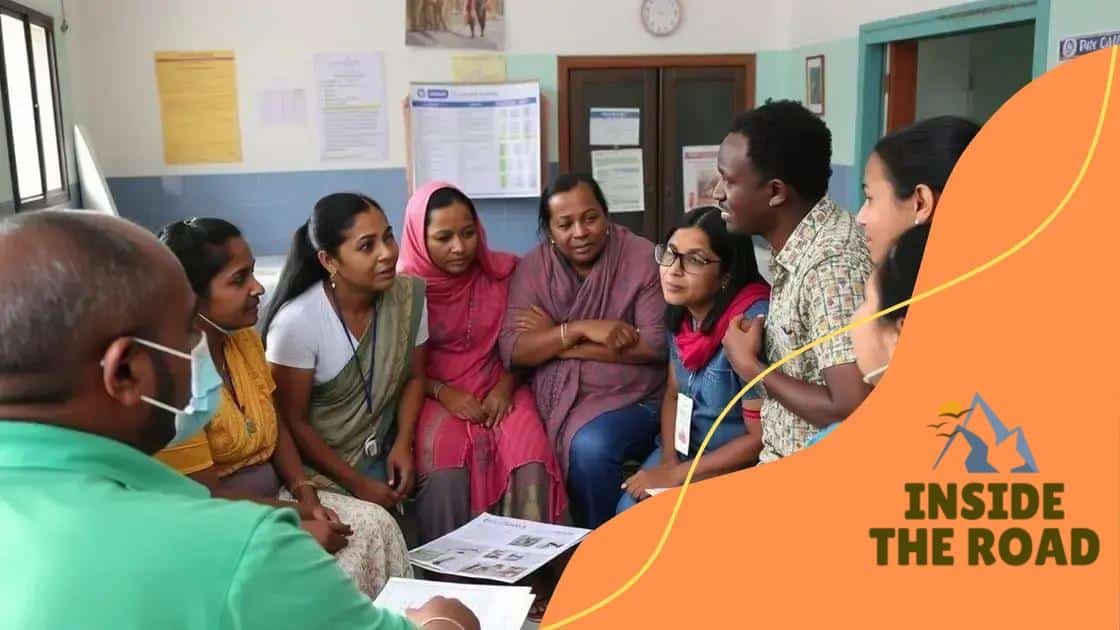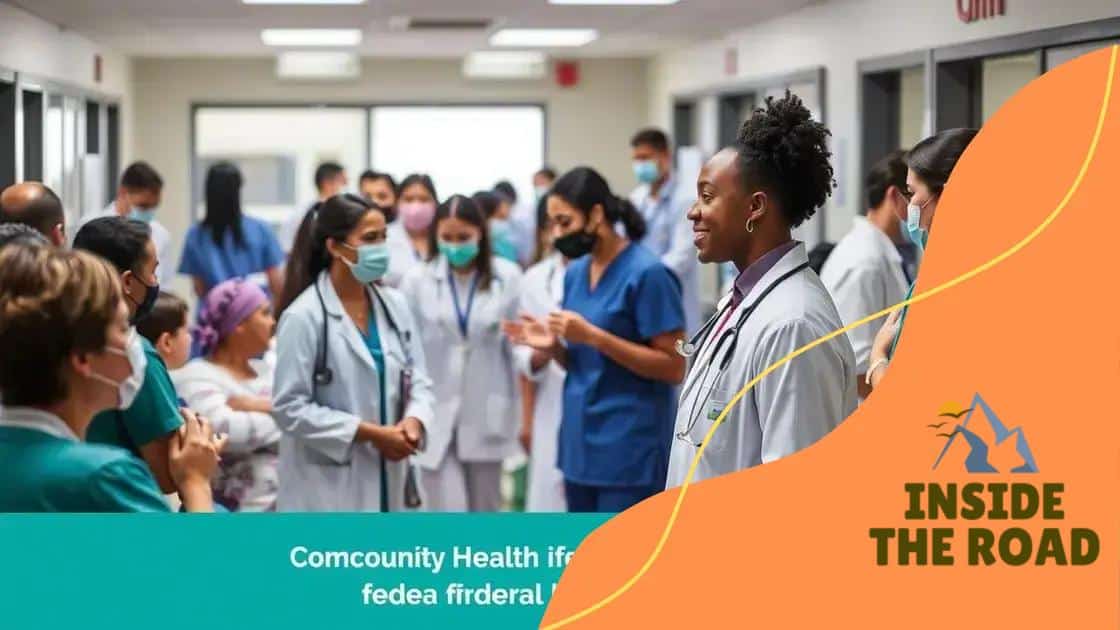Federal grants for education and healthcare opportunities

Federal grants for education and healthcare in underserved communities provide essential funding to improve access to services, enhance resources, and foster economic development.
Federal grants for education and healthcare in underserved communities play a pivotal role in bridging resource gaps. Have you ever wondered how these funds truly enhance access to crucial services? Let’s dive in and explore their significance.
Understanding federal grants and their purpose
Understanding federal grants is crucial for making the most of available resources. These grants are designed to support initiatives that benefit the public. In the context of education and healthcare, they play a significant role in underserved communities.
Federal grants are provided by various government agencies to help improve the quality of life. For instance, educational grants can fund programs that enhance learning opportunities for students. On the other hand, healthcare grants facilitate access to essential medical services.
Types of Federal Grants
There are different types of federal grants available. Here’s a quick overview:
- Discretionary Grants: Awarded based on merit, these grants are competitive and require proposals.
- Mandatory Grants: These are provided based on eligibility criteria and do not require a proposal.
- Block Grants: These grants give states more flexibility in how they use the funds for specific programs.
Understanding these types helps applicants determine which grants suit their needs best. The aim is always to address gaps in education and healthcare services.
Furthermore, the impact of these grants extends beyond immediate benefits. They often lead to sustainable programs and initiatives that foster long-term improvements. For example, a grant for an after-school program can significantly enhance educational outcomes.
Eligibility and Application Process
To apply for federal grants, organizations must meet certain eligibility requirements. This process can be intricate, but it’s vital for ensuring that funds support the right initiatives. Successful applicants often include:
- Schools and educational institutions that promote innovative programs.
- Healthcare providers focused on improving access in rural areas.
- Community organizations that address local health and educational needs.
With a clear understanding of federal grants, organizations can better navigate the application process. This knowledge empowers underserved communities to secure vital resources, ultimately enhancing their quality of life.
Key federal grants available for education
Key federal grants available for education are essential for enhancing learning opportunities across the country. These grants help schools, educators, and organizations implement innovative programs that can make a significant difference.
One prominent source of funding is the Title I Grant, which supports schools with high numbers of children from low-income families. This funding empowers schools to provide additional resources, improve teacher training, and enhance educational experiences.
Types of Educational Grants
There are several types of federal grants aimed at different educational needs. For example:
- Individuals with Disabilities Education Act (IDEA): This grant helps schools provide services to students with disabilities, ensuring they receive a quality education.
- Teacher Quality Partnership (TQP) Grants: These grants fund the development of strong, effective teachers through comprehensive training programs.
- 21st Century Community Learning Centers: This program supports after-school and summer learning opportunities, focusing on STEM education and enrichment activities.
Another important source of funding is the Pell Grant, which provides financial assistance to low-income college students. By alleviating some of the financial burden, it enables more individuals to pursue higher education.
Furthermore, federal funding through the Federal Supplemental Educational Opportunity Grant (FSEOG) is available for students demonstrating exceptional financial need. This grant is vital for making college more accessible and enhancing educational opportunities for diverse populations.
Understanding these key federal grants is crucial for schools and educators wishing to leverage available resources. By doing so, they can implement programs that genuinely benefit students and communities in need.
Key federal grants available for healthcare

Key federal grants available for healthcare are vital for ensuring that our communities receive adequate medical services. These grants help support health programs, enhance healthcare access, and improve overall public health outcomes.
One of the most significant sources of funding is the Health Resources and Services Administration (HRSA) grants. These grants are aimed at improving healthcare services in underserved areas, making essential medical care more accessible.
Types of Healthcare Grants
Federal healthcare grants come in various forms, designed to meet specific community needs. Some key types include:
- Community Health Center Grants: These grants support health centers that provide primary care services to low-income individuals.
- Substance Abuse and Mental Health Services Administration (SAMHSA) Grants: These funds are dedicated to improving mental health and substance abuse treatment programs.
- Medicaid Infrastructure Grants: Designed to enhance states’ ability to deliver services to Medicaid beneficiaries.
Additionally, the National Health Service Corps (NHSC) program offers scholarships and loan repayment options for healthcare providers who serve in underserved areas. This initiative helps attract and retain healthcare professionals where they are needed most.
Furthermore, state and local governments can access federal funds to bolster their healthcare initiatives. These funds often go towards public health campaigns, vaccination programs, and preventive care services. By utilizing these grants effectively, communities can enhance their healthcare systems significantly.
Understanding the available federal grants is paramount for healthcare organizations looking to expand services. Utilizing these resources can lead to tangible improvements in healthcare access and quality for all community members.
Impact of grants on underserved communities
The impact of grants on underserved communities is both profound and far-reaching. Federal grants provide critical resources that enhance the quality of life for many individuals living in these areas.
One key benefit of these grants is improved access to essential services, including healthcare and education. For instance, healthcare grants enable clinics to offer free or reduced-cost medical services. This contributes to better health outcomes in communities that might otherwise lack adequate care.
Enhancing Educational Opportunities
Grants also play a pivotal role in expanding educational programs. With funding, schools can develop programs that cater to the unique needs of their students. This can include:
- After-school tutoring programs that help students improve their academic skills.
- Access to technology to bridge the learning gap in digital literacy.
- Scholarship opportunities for higher education, making college more attainable.
These educational initiatives help foster a more knowledgeable and skilled workforce, ultimately benefiting the community as a whole.
Moreover, grants contribute to economic development by funding community projects. This can lead to job creation and infrastructure improvements, which are vital for revitalizing underserved areas. When communities have access to better facilities and services, residents are more likely to thrive.
Promoting Social Cohesion
Furthermore, grants facilitate the development of programs that promote social cohesion. Community organizations often receive funding to create events that bring people together. These initiatives cultivate a sense of belonging and encourage community participation, strengthening social ties among residents.
In summary, the impact of federal grants on underserved communities is significant. They empower individuals, enhance access to crucial services, and promote overall social and economic well-being.
How to apply for federal grants effectively
Applying for federal grants effectively can significantly improve your chances of securing funding. Understanding the process and preparing adequately are key steps toward success.
First, research is essential. You should identify grants that align with your organization’s goals or projects. Many federal agencies have websites that list available grants. Look for opportunities from agencies like HRSA for health projects and DOE for educational initiatives.
Steps to a Successful Application
Follow these steps to create a strong application:
- Read the Guidelines: Carefully review all instructions provided for the grant application. Each grant has specific eligibility requirements and application procedures.
- Gather Required Documents: Collect necessary documents, such as budgets, organizational charts, and letters of support. Ensure all information is accurate and up to date.
- Develop a Clear Proposal: Clearly outline your project goals and how they align with the grant’s purpose. Use data and examples to support your arguments.
- Plan for Evaluation: Describe how you will measure the success of your project. Federal agencies often appreciate detailed evaluation plans.
Furthermore, attend workshops or webinars related to grant writing. Many organizations and institutions offer resources that can enhance your skills in crafting proposals.
After submitting your application, be prepared for follow-up questions or requests for clarification. This responsiveness can demonstrate your commitment and professionalism to the funding agency.
By following these steps and maintaining attention to detail, your organization can improve its chances of securing federal grants and making a positive impact in your community.
FAQ – Frequently Asked Questions About Federal Grants for Education and Healthcare
What are federal grants for education and healthcare?
Federal grants are funds provided by government agencies to support educational and healthcare initiatives, especially in underserved communities.
How can I find federal grants suitable for my organization?
You can find federal grants by visiting government websites, such as Grants.gov, which lists available funding opportunities across various sectors.
What steps should I take to apply for a federal grant?
To apply for a federal grant, research available grants, gather necessary documents, write a clear proposal, and submit your application before the deadline.
What is the impact of federal grants on communities?
Federal grants improve access to essential services like education and healthcare, enhance community resources, and foster economic development.






